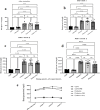Rice bran extract attenuates cognitive impairment by enhancing pancreatic β-cell insulin secretion in STZ-induced diabetic rats targeting the PPARγ/PDX1 pathway
- PMID: 40536613
- PMCID: PMC12178994
- DOI: 10.1007/s11011-025-01639-1
Rice bran extract attenuates cognitive impairment by enhancing pancreatic β-cell insulin secretion in STZ-induced diabetic rats targeting the PPARγ/PDX1 pathway
Abstract
Type I diabetes (T1D), also known as juvenile diabetes, is an autoimmune disease that causes gradual destruction of pancreatic cells and leads to intellectual disability, neuropathy, cognitive impairment, and impaired learning ability in children. Despite standard treatment with synthetic human insulin, T1D patients can maintain up to 40% of their insulin-producing islets. PPARγ receptor activation research that aims to restore β-cell biology could help reverse the loss of pancreatic mass that comes with getting older and improve β-cell function. Egyptian RB ethanol extract (RBE), previously reported with PPARγ agonist activity, showed an increase in insulin secretion both in vivo and in INS-1 cells. The exact antidiabetic RBE mechanism is still unclear. The present study aims to investigate the molecular RBE mechanism in glucose-stimulating insulin secretion and restoration of β cell function. A diabetic rat streptozotocin (STZ) model was used; five groups were designed. The STZ-diabetic rats were treated with RBE daily for 21 days compared to an insulin-treated group. Biochemical parameters and quantitative RT-PCR of β-cell genes related to the PPAR/PDX1 signaling pathway were performed, and the influence on cognitive ability was confirmed by behavioral testing (Y-maze and NOR) and histological examination. The RBE-treated group reversed blood glucose, Glut2, Ca2 +, and insulin levels in diabetic rats, with pancreatic insulin levels significantly increasing compared to the insulin group. With the exception of PDX1, RBE boosted PPARγ, SERCA, and PrKC gene expression. RBE also restored cognitive functions. This study suggests that RBE may enhance memory and cognition by increasing peripheral insulin secretion through PPARγ regulator activity.
Keywords: Cognition; Diabetes; Insulin; PPARγ; Rice bran extract.
© 2025. The Author(s).
Conflict of interest statement
Declarations. Competing interests: The authors declare no competing interests.
Figures







References
-
- Abd El Fattah MA, Abdelhamid YA, Elyamany MF, Badary OA, Heikal OA (2020) Rice bran extract protected against LPS-induced neuroinflammation in mice through targeting PPAR-γ nuclear receptor. Mol Neurobiol 58(4):1504–1516. 10.1007/s12035-020-02196-7 - PubMed
-
- Ahuja U, Ahuja SC, Thakrar R, Singh RK (2008) Rice–a nutraceutical. Asian Agri-History 12(2):93–108
-
- Al-Okbi SY, Ammar NM, Mohamed D, Helal A (2014) Egyptian rice bran oil: chemical analysis of the main phytochemicals. Riv Ital Sostanze GR 90(1):47–58. Available from: https://www.researchgate.net/publication/265385777
-
- Anwana AB, Garland HO (1991) Intracellular dehydration in the rat made diabetic with streptozotocin: effects of infusion. J Endocrinol 128(3):333–337. 10.1677/joe.0.1280333 - PubMed
MeSH terms
Substances
LinkOut - more resources
Full Text Sources
Miscellaneous

